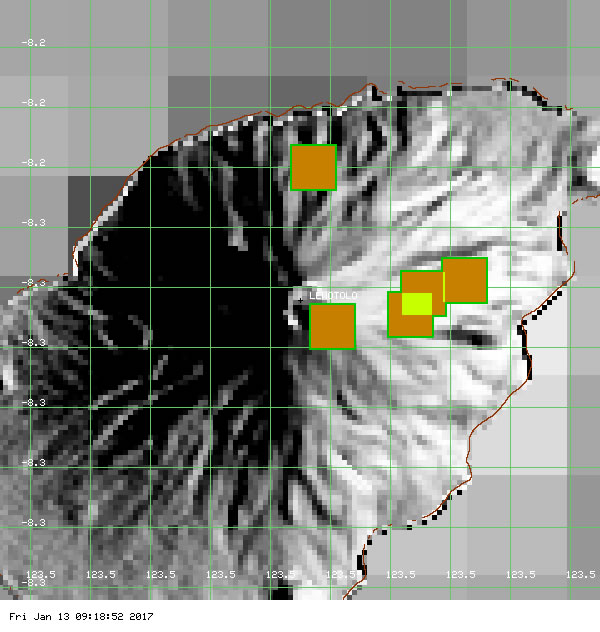Report on Lewotolok (Indonesia) — September 2016
Bulletin of the Global Volcanism Network, vol. 41, no. 9 (September 2016)
Managing Editor: Edward Venzke.
Research and preparation by Paul Berger.
Lewotolok (Indonesia) Thermal hotspots during 27 September-4 October 2015
Please cite this report as:
Global Volcanism Program, 2016. Report on Lewotolok (Indonesia) (Venzke, E., ed.). Bulletin of the Global Volcanism Network, 41:9. Smithsonian Institution. https://doi.org/10.5479/si.GVP.BGVN201609-264230
Lewotolok
Indonesia
8.274°S, 123.508°E; summit elev. 1431 m
All times are local (unless otherwise noted)
During December 2011-January 2012, Lewotolo's seismic activity increased and the volcano produced thick, white plumes that rose as high as 250 m above the summit before subsiding (BGVN 36:12). Since that episode, no further activity was observed through 31 December 2016, except for several thermal anomalies during 27 September 2015-4 October 2015, as recorded by MODIS satellite instruments analyzed using the MODVOLC algorithm (figure 2).
Geological Summary. The Lewotolok (or Lewotolo) stratovolcano occupies the eastern end of an elongated peninsula extending north into the Flores Sea, connected to Lembata (formerly Lomblen) Island by a narrow isthmus. It is symmetrical when viewed from the north and east. A small cone with a 130-m-wide crater constructed at the SE side of a larger crater forms the volcano's high point. Many lava flows have reached the coastline. Eruptions recorded since 1660 have consisted of explosive activity from the summit crater.
Information Contacts: Hawai'i Institute of Geophysics and Planetology (HIGP), MODVOLC Thermal Alerts System, School of Ocean and Earth Science and Technology (SOEST), Univ. of Hawai'i, 2525 Correa Road, Honolulu, HI 96822, USA (URL: http://modis.higp.hawaii.edu/, http://modis.higp.hawaii.edu/).


